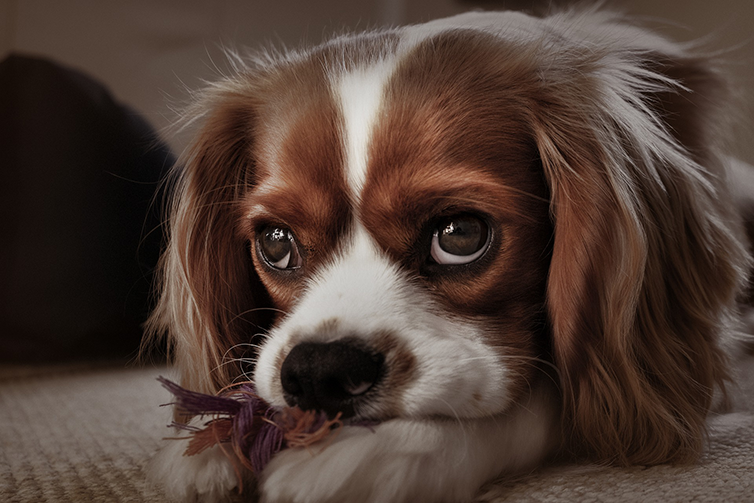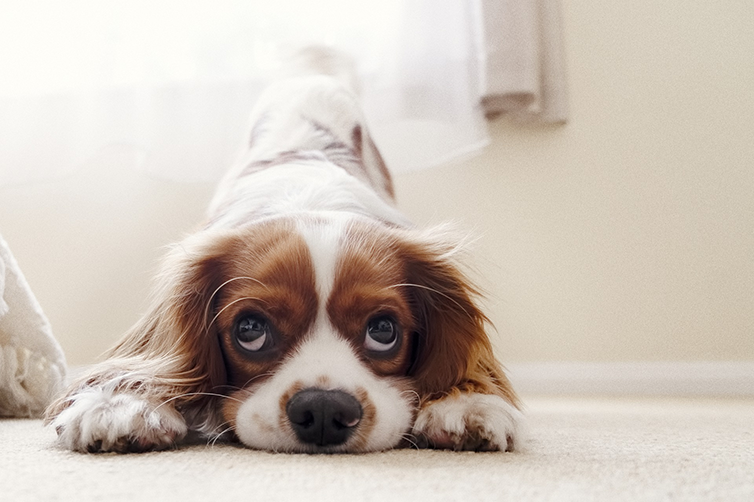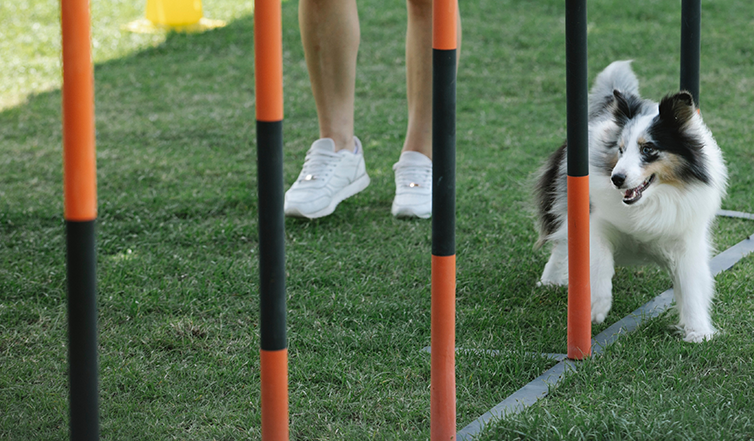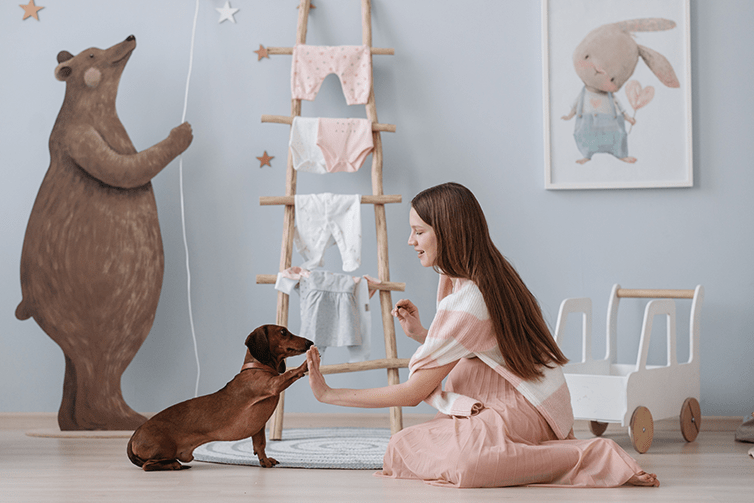Help! My Pup is Out of Control!

Dear Bravecto® SA,
I’m an avid reader of your interesting blogs and I wondered if you could help me with my problem. I have a new addition to my family: a beautiful 6-months-old spaniel puppy called Delilah, who my family and I love to pieces, but, quite frankly, she’s driving us crazy. In a nutshell, she’s chewed my expensive shoes, uses our carpets as her toilet, almost wrenches my arm off when she’s on the leash and attacks other dogs and other people whom she doesn’t know.
I took her once to a socialization class, where she was easily the naughtiest dog in the group and did not seem to be teachable. This is an awful thing for me to admit, but I am actually beginning to resent and dislike her. I have considered private lessons from an animal behaviourist but we are not in a position to be able to afford this, so it would be a last resort.
I would be most grateful for any advice you can give me.
Regards
Desperate Doris
This letter is fictitious, but Doris’s problem is not. Who is The Boss in her family? Right. It’s Delilah, of course. Who should be The Boss? Well, Doris and/or her husband.
Obviously, Delilah needs to be trained before there’s a divorce in the family or Doris and her husband start to consider finding Delilah another home or even taking her to the SPCA. This sounds like a drastic step but there are plenty of beautiful dogs sitting in animal welfare institutions because their owners could not control them.
Let’s make our position here clear. This blog is not a substitute for a proper, trained animal behaviourist. However, we have done lots of research into this problem and feel that we can give you some basic tips to help you on the road to training your dog.
A dog who is under control and has learnt some ‘good’ behaviours will be far easier to control
There are several basic obedience commands which, if done properly, Delilah and her mom, Doris, will enjoy and which will make the lives of the whole family, much easier and more pleasant. However, you need to accept that training takes a lot of time and patience. Above all, do not resort to losing your temper with your dog. If he/she does not ‘catch on’ easily and quickly, it is not your pooch’s fault. Training should, and can be, fun for all concerned.
When To Begin

Is Delilah, at 6 months old, too young for training? Absolutely not. Puppy training, especially house training, should begin on the day you take your pup home for the first time. Traditionally, dog training in the past was delayed until the dog was 6 months old. Remember that, like a child, your doggie is learning from every experience, right from birth. If you wait until 6 months, you and your pup are missing all those weeks when he/she could have been learning the behaviours you want your doggie to learn.
Food Lure Training
As the name suggests, bits of food are used to motivate Delilah to adopt the desired behaviour. The doggie is shown the bit of food, the command is given and the food is moved appropriately to encourage the behaviour. For example, food moved close to the floor, accompanied by the command ‘Down’, should elicit the desired response. Gradually, the word ‘Down’ will be associated with the action of lying down.
Eventually, you can begin to just give the command without the food or treat and with praise, and an affectionate pat, alone. This may take some time so try not to get impatient with a reluctant learner.
What You Will Need
- You should have an area which is as free from distractions as possible, at least initially. This will probably be indoors with only you and your pooch present. ‘Real life’, however, is not free from distractions, so as you progress with your training, you will need to move to areas with more distractions, with more noises, more people and more dogs.
- You will need plenty of small treats as rewards. If your dog is ‘food driven’, then small bits of enticing food should be prepared. You can use shop-bought treats, but be careful of your dog’s calorie intake as these can be fattening.
- A short leash and harness will be needed to help control your doggie initially.
The Basic Method
As we have mentioned in previous blogs, you cannot effectively train any animal (or human for that matter) by punishing them when they do not do what you ask of them. Punishment and so-called negative reinforcement, do not work effectively and will only serve to make your dog afraid of you. Behaviourists, possibly without exception, use positive reinforcement to train animals. This simple but effective system uses rewards to reinforce ‘good’ or ‘correct’ behaviour. ‘Incorrect’ behaviour is ignored – never punished.
Every dog owner has, at some point, yelled at their pooch for being ‘naughty’. In the meantime, poochie has already forgotten the fact that he/she has peed on the lounge carpet and cannot, with his canine brain, associate the shouting with the pee. Your doggie will be confused and you will be in a state of anxiety. Mop up the pee with as little ceremony as possible. When poochie pees outside, praise, praise, praise, and give him/her a treat immediately.
Be Realistic
Do not expect your doggie to pick up commands or tricks after only a few tries. It takes a lot of time for most dogs to learn something new. And always bear in mind that your dog will learn much quicker with praise, praise, praise, and, at least initially, a few treats. Eventually, he/she will associate the desired behaviour with the praise alone. Training sessions should not be longer than around 5 minutes initially. Approximately 15 minutes per day should be spent in training. All members of the family should participate and reinforce what you have been teaching your pup. Try to train in all the rooms in your house and in your garden. Your puppy should not get the impression that he/she must only follow your commands in one room.
Socialization

This, like any other form of training, should begin as soon as you first take your puppy home. The socialization period begins at around 7 weeks and extends to 14-16 weeks. During this period, puppies are eager and motivated to accept other people and other dogs. After this period they may become reluctant or even fearful of training.
Training classes can be very useful and serve many functions. The trainers can demonstrate various techniques and guide you through various processes. Your pup will be learning in a ‘real’ environment, with real life distractions, and will meet other dogs and other people.
Remember to ensure that your puppy has had all of his/her vaccinations and that he/she is free from any parasites. Bravecto® produces some excellent products in this regard, and Bravecto® treatments last for 3 months and over, so that you don’t need to remember to dose your pup every month against ticks and fleas.
Let’s now look at how you go about teaching a few basic commands, and to simplify the whole he/she thing, let’s assume we’re training Doris’s pooch: Delilah.
Home Training

Sit!
Holding a treat in your hand, stand in front of Delilah with your hand a bit above her head. Use your hand to move over her head, over her back and down to her tail, at the same time saying: ‘Sit’, with your hand on her lower back until she is sitting. As soon as she does this, praise her with ‘Good dog!’ or ‘Good girl!’, and give her the treat. Most trainers will advise you not to apply pressure or force your dog to sit. Repeat this procedure several times. Eventually, after several sessions, she should sit with only the command and not the treat.
Down!
Once Delilah is sitting on command, you can teach her the ‘Down!’ command. With her in the ‘Sit!’ position, crouch down in front of your dog. Holding a treat in front of her nose, guide her down by lowering the treat to the ground while saying ‘Down!’ If she just slouches and is not totally down, move the treat away from and towards your dog to guide her. When she is fully down, say ‘Down’ again, praise and reward.
If you are still having trouble getting your pooch to go down fully, light pressure and a tap on her shoulder should help. Do not press hard as you may hurt your dog.
Stay!
Once Delilah has mastered the sit and down commands, you may move on to teaching her to Stay! Begin with your poochie in the sit or down position, on a short lead. While saying ‘Stay!’, put your hand up, palm facing your dog. Keeping eye contact move backwards a short distance. If she stays in position, move towards her, praising and giving her a treat. You can gradually move away, making the distance, and the lead length, longer. If she starts to come towards you, guide her back to the sitting or down position and try again. Remember: never punish or shout if she gets it wrong. Ignore her mistakes and praise her successes.
Come!
Delilah should be in the sit or down position, on a longer lead. Walk a short distance away from her and say ‘Come’, gesturing with your hand for her to come to you. Do not pull her with the lead. If she is reluctant to come to you, crouch down and in a very encouraging voice, tell her to ‘come’ again. When she complies, praise and reward. Eventually, you should be able to practise without the leash.
Do not rush into ‘off-leash’ practise, especially if you are in a dog park or outside your house or garden. Before she has been thoroughly trained, this could put her in danger from traffic and other dogs.
And finally…
A trained dog, who knows who’s The Boss, is a happy dog with a happy owner. We wish you many enjoyable training sessions which result in a pooch who is a pleasure to have around.
Sources:
https://www.thesprucepets.com ‘How to Completely Train Your Dog’
https://www.instructables.com ‘Basic Obedience Training for Dogs’
https://vcahospitals.com ‘Puppy Behaviour and Training- Training Basics’
Subscribe to our Newsletter
Get to know your furry friend better! Sign up for all things dog- or cat-related.
The Hairy Facts about the dreaded hairball
12 April 2021
Help! My dog’s barking mad! Volume 2
12 April 2021
Your Itchy, Scratchy Cat – All About Cat Skin Problems
12 April 2021
The Dog’s Diet: A Bone of contention?
01 April 2021
Mango Fly Worms: How to Spot and Eliminate them
Posted on November 28,2019
Managing Mange And Mites In Your Dog
Posted on June 11,2018
Why Do Cats Purr and How? Learn What Your Cat Is Saying
Posted on October 14,2020
How to Get Rid of Ear Mites in Dogs
Posted on November 06,2019









